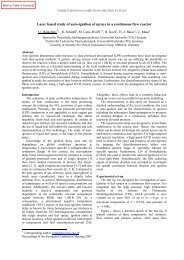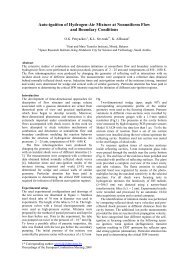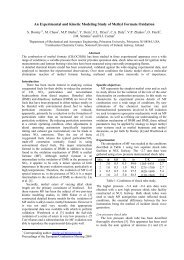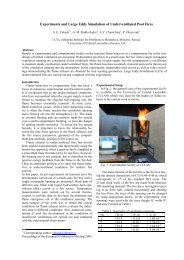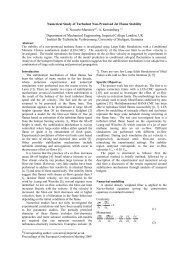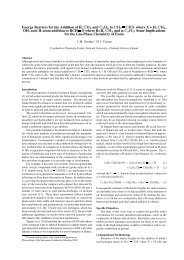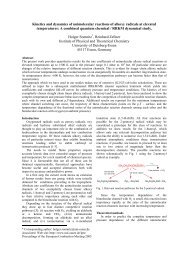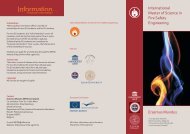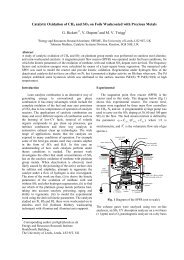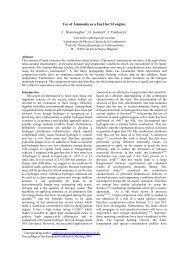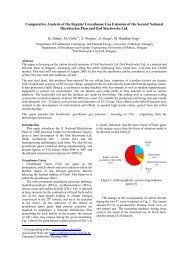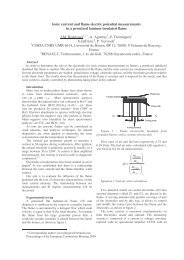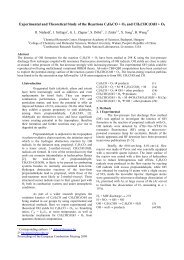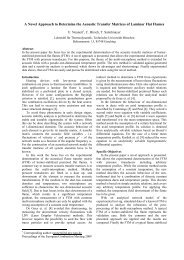135 - Combustion Institute British Section
135 - Combustion Institute British Section
135 - Combustion Institute British Section
You also want an ePaper? Increase the reach of your titles
YUMPU automatically turns print PDFs into web optimized ePapers that Google loves.
Experiments with Progress Variable Approach in the Contest of<br />
Large Eddy Simulation for <strong>Combustion</strong><br />
Rajani Kumar Akula*, Amsini Sadiki, Johannes Janicka<br />
Chair of Energy and Powerplant Technology, TU-Darmstadt, Germany<br />
Petersenstr. 30, Darmstadt, Germany-64287.<br />
Tel.: +49 6151 165697, Fax: +49 6151 166555, Email: akula@ekt.tu-darmstadt.de<br />
Abstract<br />
The main aim of the present work is to investigate the influence of the different approaches<br />
(based on the progress variable) on the behaviour of the premixed flame front prediction by using<br />
Large Eddy Simulation. These approaches are thickened flame approach and explicit filter based<br />
progress variable method. To this purpose a configuration providing the bluff body stabilized<br />
flame has been used. As a first step velocity predictions are reported in this work.<br />
Introduction<br />
Large eddy simulations (LES) are now<br />
viewed as a promising tool to address<br />
combustion problems where classical<br />
Reynolds-averaging numerical simulations<br />
(RANS) approaches have proved to lack<br />
precision or where the intrinsically unsteady<br />
nature of the flow makes RANS clearly<br />
inadequate. LES allows a better description<br />
of the turbulence–combustion interactions<br />
because, large structures are explicitly<br />
computed and instantaneous fresh and burnt<br />
gases zones, where turbulence characteristics<br />
are quite different, are clearly identified [1].<br />
But LES of premixed combustion is difficult<br />
due to the thickness of the premixed flame<br />
about 0.1–1 mm and generally smaller than<br />
the LES mesh size. To overcome this<br />
difficulty several approaches have been<br />
developed, such as flame front tracking<br />
techniques (e.g., the G equation [2–4]),<br />
simulating filtered progress variables [5],<br />
and the so called thickened flame approach<br />
(TF-LES). In the later the diffusion and preexponential<br />
factors in the Arrhenuis law<br />
based reaction term are modified so as to<br />
yield an artificially thickened flame [7–10].<br />
However in all the techniques used, a model<br />
is needed to account for the fact that the real<br />
unresolved flame is wrinkled at scales below<br />
the LES resolution, which typically provides<br />
an increased surface area for the flame and<br />
thus an increased reaction rate. This model is<br />
introduced through the flame wrinkling<br />
factor. To measure the influence of these<br />
methods to capture the behaviour of the<br />
premixed flame front, we consider the socalled<br />
VOLVO test case referred as<br />
Validation Rig 1 (VR 1), as detailed<br />
experimental results are available. In this<br />
paper we concentrate on the velocity<br />
predictions for this case. For the simulations<br />
we follow dynamic SGS model. Germano et<br />
al. [11] developed a dynamic SGS model<br />
(DSM) which overcomes some of the<br />
aforementioned drawbacks of the<br />
Smagorinsky model. This model has many<br />
desirable features in that it requires only one<br />
input parameter, i.e., ratio of test filter width<br />
and grid filter. DSM has been successfully<br />
applied to LES of transitional and turbulent<br />
channel flows [11] and both incompressible<br />
and compressible isotropic turbulence [12].<br />
However, the dynamically computed model<br />
coefficient was averaged either in the global<br />
volume of the domain or in a homogeneous<br />
plane. To overcome this problem Meneveau<br />
et al. [12] has proposed a Lagrangian<br />
dynamic model. In this work we have used<br />
this Lagrangian dynamic model.<br />
Numerical Procedure and Modelling<br />
The governing equations are discretised on a<br />
block structured boundary- fitted collocated<br />
grid following the finite-volume approach.<br />
Spatial discretisations are 2nd order with
flux blending technique for the convective<br />
terms. The solution is updated in time using<br />
2nd order accurate implicit Crank-Nicolson<br />
scheme. A SIMPLE type pressure correction<br />
is used for pressure-velocity coupling. The<br />
resulting set of linear equations is solved<br />
iteratively. Details of the method can be<br />
found in the paper by Mengler et al. The<br />
basic governing equations for LES of<br />
premixed combustion are then the favre<br />
filtered continuity, Navier-Stokes equations<br />
and the progress variable<br />
∂ ρ ∂ρu<br />
i + = 0<br />
∂t ∂xi<br />
(1)<br />
∂ρu i ∂<br />
( ∂p<br />
+ ρuu<br />
i j)<br />
=− +<br />
∂t ∂xj ∂xi<br />
∂ ⎡ ⎛∂u2 j ∂ui ∂u<br />
⎞ ⎤<br />
k<br />
⎢ρυ ⎜ + − δij ⎟+ ρTij<br />
⎥<br />
∂xj ⎢ ⎜ ∂xi ∂xj 3 ∂x<br />
⎟<br />
⎣ ⎝ k ⎠ ⎥<br />
⎦<br />
∂ρc<br />
+∇⋅ ( ρuc ) =∇⋅( ρD∇<br />
c)<br />
+<br />
∂t<br />
(2)<br />
⎛ Ea<br />
⎞<br />
Aρ(1 −c) exp ⎜− ⎟<br />
⎝ RT ⎠<br />
filter represented by a tilde in accordance<br />
with the Germano procedure. The purpose of<br />
doing this is to utilize the information<br />
between the grid- and test-scale filters to<br />
determine the characteristics of the SGS<br />
motion. The Smagorinsky coefficient can be<br />
then calculated dynamically using the<br />
following expression 5 :<br />
LM<br />
C = (3)<br />
M M<br />
2<br />
s<br />
ij ij<br />
ij ij<br />
where<br />
M<br />
<br />
SS<br />
<br />
SS<br />
2 2<br />
ij =−2∆ ij + 2∆ij<br />
<br />
Lij = uiu j −uiuj<br />
or<br />
= T <br />
ij −τij<br />
<br />
T = uu − u u<br />
ij i j i j<br />
∆ is a test filter width and<br />
S<br />
<br />
= ( ) 1/2<br />
S<br />
<br />
S<br />
<br />
.<br />
2 mn mn<br />
Different dynamic techniques can be applied<br />
to compute Eq. (3). Among these the<br />
Lagrangian dynamic model from Meneveau<br />
[13], is geometry independent and hence will<br />
be used for the complex geometries,<br />
considered for this work.<br />
Tildas () ⋅ refer to Favre-filtered variables,<br />
whereas overbars ( ⋅ ) refer to simple spatial<br />
filtering ( c = ρc/ ρ ).<br />
The effect of the unresolved subgrid scales is<br />
represented by the SGS stress<br />
τ ij = uu i j − uiuj (3)<br />
In the Smagorinsky model, the anisotropic<br />
a<br />
part of the SGS-turbulent stress, τ ij , is related<br />
to the resolved strain-rate tensor S ij by<br />
( ) 1/2<br />
To consider premixed processes, LES for<br />
premixed combustion is done using the<br />
thickened flame formulation (TF-LES). The<br />
basic idea of the thickened flame approach<br />
(see [7, 8]) is to simulate an ‘equivalent<br />
o<br />
flame’ of thickness F δ l (F is thickened<br />
o<br />
factor, δl is original flame thickness) which<br />
has the same reaction rate as the real flame.<br />
The thickening factor F is chosen such that<br />
the flame can be well represented on the<br />
a<br />
2<br />
τ ij =−2( Cs∆ ) 2SmnSmnSij<br />
(4)<br />
o<br />
o<br />
LES mesh. Typically, F / δ l = n ∆ mesh / δ l ,<br />
where n is the number of grid-points (with<br />
where Cs represents the Smagorinsky mesh-spacing ∆ mesh ) one wishes to place<br />
coefficent. To compute this coefficient for<br />
across the flame front (typically n =4–10).<br />
complex geometries we introduce a test scale
For laminar plane unstrained flames, a thick<br />
flame is achieved by increasing the<br />
diffusivity by F and by dividing the preexponential<br />
factor in the Arrhenius law by F<br />
[7, 8]. In terms of a resolved progress<br />
variable c , the balance equation now<br />
becomes<br />
∂ρc<br />
+∇⋅ ( ρuc ) =∇⋅( ρDF∇<br />
c<br />
) +<br />
∂t<br />
(4)<br />
A ⎛ Ea<br />
⎞<br />
ρ(1<br />
−c) exp ⎜− ⎟<br />
F ⎝ RT ⎠<br />
As explained in Ref. [9], the thickened flame<br />
approach has several attractive features: (1)<br />
From a numerical point of view, the<br />
chemical reaction is described in a way<br />
which properly tends to the DNS expressions<br />
when F→1, and whose implementation is<br />
attractive since it has the same form as DNS<br />
(i.e., the same code can be used for LES and<br />
DNS). (2) Because of the use of an<br />
Arrhenius law, various phenomena such as<br />
ignition, flame stabilization, flame/wall<br />
interactions, and so forth can be described, at<br />
least qualitatively.<br />
However, as discussed in Refs. [8] and [9]<br />
the thickening of the flame implies that<br />
flame turbulence interaction is modified<br />
since the Damköhler number Da comparing<br />
turbulent and chemical time scales is<br />
decreased by the factor F when thickening<br />
the flame. Thus, the response of the<br />
thickened flame to the spectrum of eddies<br />
found in turbulent flows will not be the same<br />
as that of the unthickened flame. Moreover,<br />
it obviously cannot be wrinkled at scales<br />
below the resolution limit of the LES. To<br />
account for this a so-called efficiency<br />
function E is introduced for the specific<br />
purpose of increasing the reaction velocity<br />
from the laminar value o<br />
l<br />
s to a larger value<br />
E o<br />
s l [8, 9]. In these references, the<br />
relationship between E and the wrinkling<br />
Ξ ∆ Ξ ∆ to<br />
normalize the results with the possible<br />
additional wrinkling of the thickened flame.<br />
In the present formulation E is set as<br />
o<br />
∆( Fu , ∆ / sl)<br />
′ Ξ by following the work [10].<br />
The resulting evolution equation for the<br />
progress variable or fuel mass fraction then<br />
takes the form:<br />
o o<br />
factor was E = ∆( / sl ) / ∆(<br />
/ Fsl<br />
)<br />
∂ρc<br />
+∇⋅ ( ρuc ) =∇⋅( ρDFΞ∆∇<br />
c<br />
) +<br />
∂t<br />
A<br />
⎛ Ea<br />
⎞<br />
Ξ∆ρ(1 −c) exp ⎜− ⎟<br />
F ⎝ RT ⎠<br />
Results and Discussion<br />
For the present investigation VOLVO<br />
configuration (VR 1) has been considered as<br />
sketched in Fig.1.<br />
Fig. 1 Bluff body test configuration<br />
It is a bluff body stabilized flame<br />
configuration, and consists of a rectilinear<br />
channel with rectangular cross section,<br />
divided into an inlet section and a<br />
combustion section equipped with a twodimensional<br />
triangular shape flame holder.<br />
The channel is 0.24m width and 0.12m high.<br />
The blockage ratio of the obstacle was 1/3.<br />
The primary intention of this rig is to<br />
investigate phenomena occurring in<br />
afterburners for jet engines.<br />
In the simulations inlet composition assumed<br />
to consist of propane and air, premixed at<br />
equivalence ratio 0.65. For a typical nonreactive<br />
case inlet temperature is 298K,<br />
while for the corresponding reactive case<br />
inlet temperature is 600K. The mass flow<br />
rate into the combustor was 0.60kg/s giving<br />
47500 in the non-reactive case and
Re=24200 in the reactive case. Only the<br />
velocity predictions of reactive case are first<br />
presented in this work. We have used the<br />
120×42×16 grid resolution after the obstacle.<br />
Fig 1 shows the instantaneous velocity<br />
distribution and Fig. 3 shows the mean<br />
velocity distribution. Fig 2 shows the isosurface<br />
velocity plot for velocity equal to 30<br />
m/s. Nevertheless if we include the<br />
combustion phenomena one can expect<br />
smooth velocity field distribution unlike the<br />
present simulation predictions. Due to the<br />
non-availability of the experimental data we<br />
are not able to compare the simulation<br />
results with the experimental data. But<br />
experimental data for the temperature<br />
distribution is available. This data will be<br />
used in the future for the evaluation of the<br />
LES of premixed combustion model. Fig. 1<br />
and Fig. 3 successfully predict the vortexes<br />
after the bluff-body obstacle.<br />
Conclusions<br />
In the present work we have successfully<br />
predicted the velocity distribution for the<br />
bluff body stabilized flame configuration.<br />
Due to the non-availability of the<br />
experimental data we are not able to<br />
compare the simulation results<br />
1)J. Janicka, A. Sadiki., Proc. Comb. Inst: 30<br />
(In Press) (2004)<br />
2)Kerstein, A. R., Ashurst, W., and<br />
Williams, F. A., Phys. Rev. A 37(7):2728–<br />
2731 (1988).<br />
3)Menon, S., and Jou, W. H., Combust. Sci.<br />
Technol. 75:53–72 (1991).<br />
4)Smiljanovski, V., Moser, R. D., and Klein,<br />
R., <strong>Combustion</strong> Theory and Modelling<br />
1(2):183–215 (1997).<br />
5)Boger, M., Veynante, D., Boughanem, H.,<br />
and Trouve´, A., Proc. Combust. <strong>Institute</strong><br />
27:917–926 (1998).<br />
6)Butler, T., and O’Rourke, P., Proc.<br />
Combust. <strong>Institute</strong> 16:1503–1516 (1977).<br />
7)O’Rourke, P., and Bracco, F. V., J. Comp.<br />
Phys. 33:185–203 (1979).<br />
8)Angelberger, C., Veynante, D.,<br />
Egolfopoulos, F., and Poinsot, T., Annual<br />
Research Briefs 1998, Center for Turbulent<br />
Research, NASA Ames/Stanford University,<br />
Stanford, CA.<br />
9)Colin, O., Ducros, F., Veynante, D., and<br />
Poinsot, T., Phys. Fluids 12(7):1843–1863<br />
(2000).<br />
10)Charlette F., Meneveau C. and Veynante<br />
D., <strong>Combustion</strong> and Flame 131:159–180<br />
(2002)<br />
11)Germano M., Piomelli U., Moin P., and<br />
Cabot W. H., Phys. Fluids A 3: 1760-1765<br />
(1991)<br />
12)Moin P., Squires K., Cabot W., and Lee<br />
S., Phys. Fluids A 3:2746-2752 (1991)<br />
13)Meneveau C., Lund T. S., and Cabot W.<br />
H., Journal of Fluid Mechanics 319: 353-<br />
385, 1996
Fig.1. Instantaneous velocity vector<br />
distribution<br />
Fig 2. Iso surface (=30 m/sec) velocity<br />
contour<br />
Fig 3.Mean velocity vector distribution



